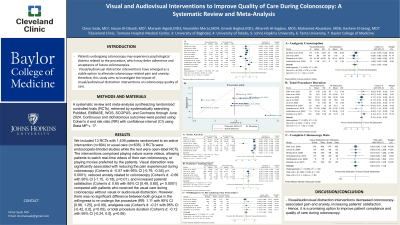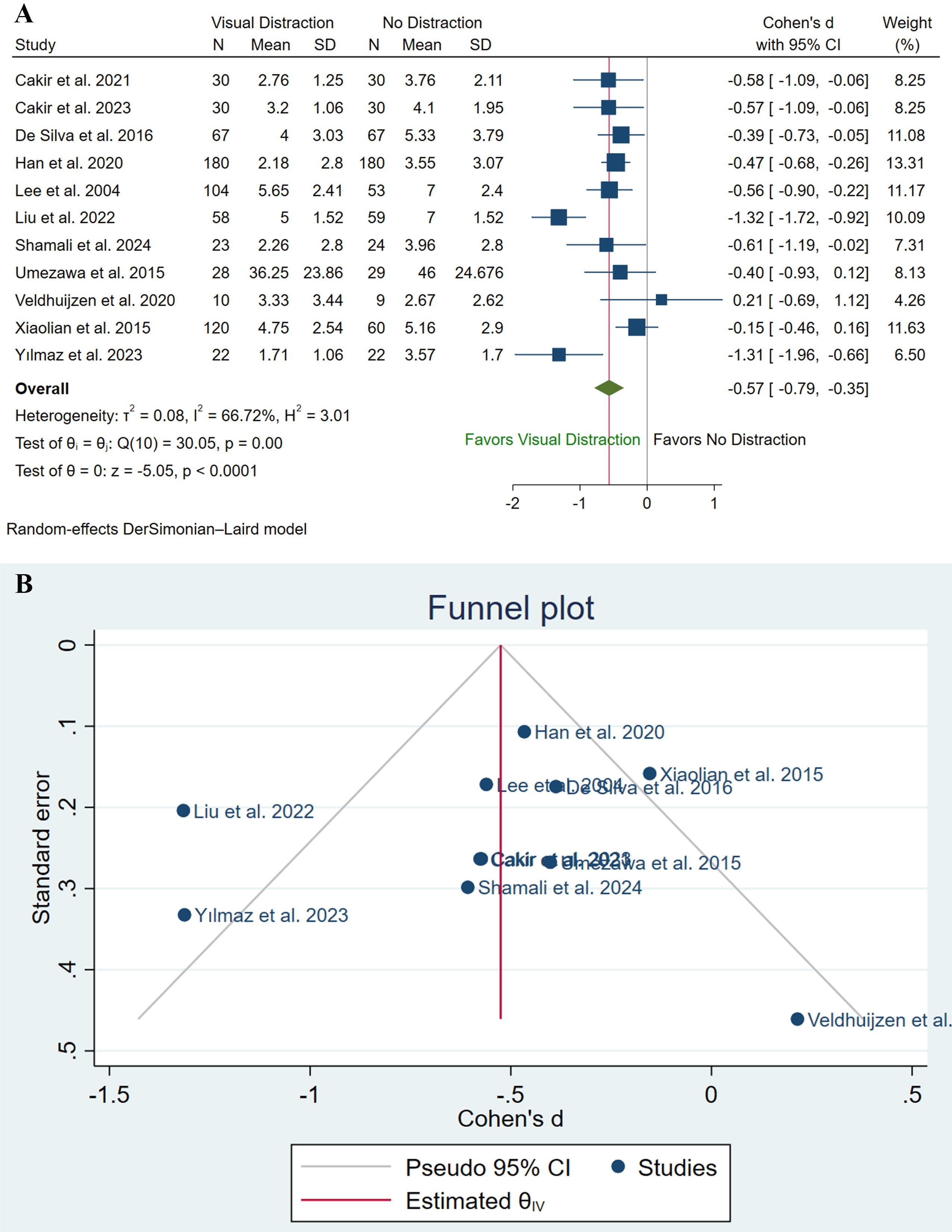Monday Poster Session
Category: General Endoscopy
P2403 - Visual and Audiovisual Interventions to Improve Quality of Care During Colonoscopy: A Systematic Review and Meta-Analysis
Monday, October 28, 2024
10:30 AM - 4:00 PM ET
Location: Exhibit Hall E

Has Audio

Omar Saab, MD
Cleveland Clinic Foundation
Westlake, OH
Presenting Author(s)
Omar Saab, MD1, Hasan Al-Obaidi, MD2, Marwah Algodi, MD3, Nooraldin Merza, MD4, Umesh Baghat, MD5, Alhareth Al-Sagban, MD6, Mohamed Abuelazm, MD7, Hashem El-Serag, MD, MPH8
1Cleveland Clinic Foundation, Westlake, OH; 2Jamaica Hospital Medical Center, Briarwood, NY; 3University of Baghdad College of Medicine, Cleveland, OH; 4University of Toledo College Medicine and Life Sciences, Toledo, OH; 5Cleveland Clinic Foundation, Cleveland, OH; 6Johns Hopkins University School of Medicine, Bristow, VA; 7Tanta University, Tanta, Al Gharbiyah, Egypt; 8Baylor College of Medicine, Houston, TX
Introduction: Patients undergoing colonoscopy may experience psychological distress related to the procedure, which may deter adherence and acceptance of future colonoscopies. Visual/audiovisual distraction interventions have emerged as a viable option to alleviate colonoscopy-related pain and anxiety; therefore, this study aims to investigate the impact of visual/audiovisual distraction interventions on colonoscopy quality of care.
Methods: A systematic review and meta-analysis synthesizing randomized controlled trials (RCTs), retrieved by systematically searching PubMed, EMBASE, WOS, SCOPUS, and Cochrane through June 2024. Continuous and dichotomous outcomes were pooled using Cohen's d and risk ratio (RR) with confidence interval (CI) using Stata MP v. 17.
Results: We included 13 RCTs with 1,439 patients randomized to an active intervention (n=804) or usual care (n=635). 3 RCTs were endoscopists-blinded studies while the rest were open-label RCTs. The interventions comprised playing nature scene videos, allowing patients to watch real-time videos of their own colonoscopy, or playing movies preferred by the patients. Visual distraction was significantly associated with reducing the pain experienced during colonoscopy (Cohen's d: -0.57 with 95% CI [-0.79, -0.35], p< 0.0001), reduced anxiety related to colonoscopy (Cohen's d: -0.66 with 95% CI [-1.15, -0.18], p=0.01), and increased patients' satisfaction (Cohen's d: 0.65 with 95% CI [0.49, 0.80], p< 0.0001) compared with patients who received the usual care during colonoscopy without visual or audiovisual distraction. However, there was no significant difference between both groups in the willingness to re-undergo the procedure (RR: 1.11 with 95% CI [0.98, 1.25], p=0.09), analgesia use (Cohen's d: -0.21 with 95% CI [-0.42, 0.0], p=0.05), or total procedure duration (Cohen's d: -0.12 with 95% CI [-0.24, 0.0], p=0.06).
Discussion: Visual/audiovisual distraction interventions decreased colonoscopy-associated pain and anxiety, increasing patients' satisfaction. Hence, it is a promising option to improve patient compliance and quality of care during colonoscopy.

Disclosures:
Omar Saab, MD1, Hasan Al-Obaidi, MD2, Marwah Algodi, MD3, Nooraldin Merza, MD4, Umesh Baghat, MD5, Alhareth Al-Sagban, MD6, Mohamed Abuelazm, MD7, Hashem El-Serag, MD, MPH8. P2403 - Visual and Audiovisual Interventions to Improve Quality of Care During Colonoscopy: A Systematic Review and Meta-Analysis, ACG 2024 Annual Scientific Meeting Abstracts. Philadelphia, PA: American College of Gastroenterology.
1Cleveland Clinic Foundation, Westlake, OH; 2Jamaica Hospital Medical Center, Briarwood, NY; 3University of Baghdad College of Medicine, Cleveland, OH; 4University of Toledo College Medicine and Life Sciences, Toledo, OH; 5Cleveland Clinic Foundation, Cleveland, OH; 6Johns Hopkins University School of Medicine, Bristow, VA; 7Tanta University, Tanta, Al Gharbiyah, Egypt; 8Baylor College of Medicine, Houston, TX
Introduction: Patients undergoing colonoscopy may experience psychological distress related to the procedure, which may deter adherence and acceptance of future colonoscopies. Visual/audiovisual distraction interventions have emerged as a viable option to alleviate colonoscopy-related pain and anxiety; therefore, this study aims to investigate the impact of visual/audiovisual distraction interventions on colonoscopy quality of care.
Methods: A systematic review and meta-analysis synthesizing randomized controlled trials (RCTs), retrieved by systematically searching PubMed, EMBASE, WOS, SCOPUS, and Cochrane through June 2024. Continuous and dichotomous outcomes were pooled using Cohen's d and risk ratio (RR) with confidence interval (CI) using Stata MP v. 17.
Results: We included 13 RCTs with 1,439 patients randomized to an active intervention (n=804) or usual care (n=635). 3 RCTs were endoscopists-blinded studies while the rest were open-label RCTs. The interventions comprised playing nature scene videos, allowing patients to watch real-time videos of their own colonoscopy, or playing movies preferred by the patients. Visual distraction was significantly associated with reducing the pain experienced during colonoscopy (Cohen's d: -0.57 with 95% CI [-0.79, -0.35], p< 0.0001), reduced anxiety related to colonoscopy (Cohen's d: -0.66 with 95% CI [-1.15, -0.18], p=0.01), and increased patients' satisfaction (Cohen's d: 0.65 with 95% CI [0.49, 0.80], p< 0.0001) compared with patients who received the usual care during colonoscopy without visual or audiovisual distraction. However, there was no significant difference between both groups in the willingness to re-undergo the procedure (RR: 1.11 with 95% CI [0.98, 1.25], p=0.09), analgesia use (Cohen's d: -0.21 with 95% CI [-0.42, 0.0], p=0.05), or total procedure duration (Cohen's d: -0.12 with 95% CI [-0.24, 0.0], p=0.06).
Discussion: Visual/audiovisual distraction interventions decreased colonoscopy-associated pain and anxiety, increasing patients' satisfaction. Hence, it is a promising option to improve patient compliance and quality of care during colonoscopy.

Figure: Analysis and Funnel Plot
Disclosures:
Omar Saab indicated no relevant financial relationships.
Hasan Al-Obaidi indicated no relevant financial relationships.
Marwah Algodi indicated no relevant financial relationships.
Nooraldin Merza indicated no relevant financial relationships.
Umesh Baghat indicated no relevant financial relationships.
Alhareth Al-Sagban indicated no relevant financial relationships.
Mohamed Abuelazm indicated no relevant financial relationships.
Hashem El-Serag indicated no relevant financial relationships.
Omar Saab, MD1, Hasan Al-Obaidi, MD2, Marwah Algodi, MD3, Nooraldin Merza, MD4, Umesh Baghat, MD5, Alhareth Al-Sagban, MD6, Mohamed Abuelazm, MD7, Hashem El-Serag, MD, MPH8. P2403 - Visual and Audiovisual Interventions to Improve Quality of Care During Colonoscopy: A Systematic Review and Meta-Analysis, ACG 2024 Annual Scientific Meeting Abstracts. Philadelphia, PA: American College of Gastroenterology.
